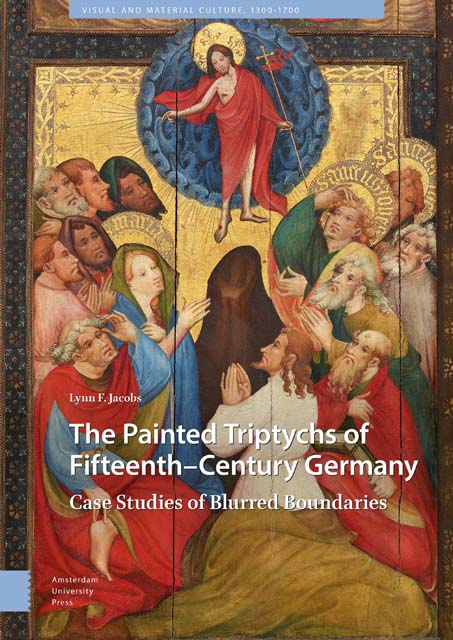Book contents
- Frontmatter
- Dedication
- Table of Contents
- List of Illustrations
- Acknowledgements
- Introduction
- 1 Framed Boundaries: Conrad von Soest and Early Fifteenth-Century Westphalian Triptychs
- 2 Transparent Boundaries: Colour on the Exterior of German Fifteenth-Century Triptychs
- 3 Regional Boundaries : Rogier van der Weyden’s Columba Altarpiece and Cross-Influences Between the Netherlands and Cologne
- 4 Spiritual Boundaries : The Master of the St. Bartholomew Altarpiece and the Border between Reality and Eternity
- 5 Coda: The Triptych in the Age of Dürer
- Bibliography
- Index
1 - Framed Boundaries: Conrad von Soest and Early Fifteenth-Century Westphalian Triptychs
Published online by Cambridge University Press: 16 November 2022
- Frontmatter
- Dedication
- Table of Contents
- List of Illustrations
- Acknowledgements
- Introduction
- 1 Framed Boundaries: Conrad von Soest and Early Fifteenth-Century Westphalian Triptychs
- 2 Transparent Boundaries: Colour on the Exterior of German Fifteenth-Century Triptychs
- 3 Regional Boundaries : Rogier van der Weyden’s Columba Altarpiece and Cross-Influences Between the Netherlands and Cologne
- 4 Spiritual Boundaries : The Master of the St. Bartholomew Altarpiece and the Border between Reality and Eternity
- 5 Coda: The Triptych in the Age of Dürer
- Bibliography
- Index
Summary
Abstract
This chapter focuses on the Niederwildungen Altarpiece of 1403, in which Conrad von Soest created multiple painted frames as well as pastiglia relief frames around the narrative scenes on the interior of his triptych—and then at various places crossed those boundaries, cutting the pastiglia to allow a part of a scene to invade its neighbour. In this work, and other works by Conrad, these transgressions of the boundaries create closer visual connections and bring out new facets of meaning. Such blurred boundaries, which may be grounded on Westphalian precedents, remain key elements in altarpieces produced by Conrad's Westphalian followers, as well as in works produced under Westphalian influence in Lower Saxony.
Keywords: Conrad von Soest, Niederwildungen Altarpiece, pastiglia, Berswordt Master, Warendorf Master
In 1403, Conrad von Soest painted an altarpiece for the city church in the town of Niederwildungen (Fig. 1.1). The work remains in that same church (now the Evangelische Stadtkirche of the renamed town of Bad Wildungen). The interior of Conrad's Niederwildungen Altarpiece follows a format that was extremely common within Westphalian triptychs of the late fourteenth and fifteenth centuries. In order to incorporate more narrative events, each of the three panels of the triptych is subdivided into separate cells, four equal-sized ones on each wing and five in the centre, with two vertically stacked cells at each side of a much larger central Crucifixion scene. Virtually the same structure is found in two Westphalian works produced in the second half of the fourteenth century—probably in the same workshop2—the Osnabrück Altarpiece (Fig. 1.2) and the Netze Altarpiece (Fig. 1.3). This format is not limited to the Westphalian region: the Lower Saxon, early fifteenth-century Göttinger Barfüßeraltar has a very similar structure, though it has three registers as opposed to the two registers of the Niederwildungen Altarpiece—as does the Cologne Kirchsahr Altarpiece of 1401–1425 (Fig. 3.2). Indeed, the tendency to subdivide the interior into multiple narrative fields, rather than showing one scene in each panel, is one of the key features that distinguished painted triptychs from Germanic regions from their Netherlandish counterparts, especially in the earlier part of the fifteenth century.
- Type
- Chapter
- Information
- The Painted Triptychs of Fifteenth-Century GermanyCase Studies of Blurred Boundaries, pp. 43 - 92Publisher: Amsterdam University PressPrint publication year: 2022



